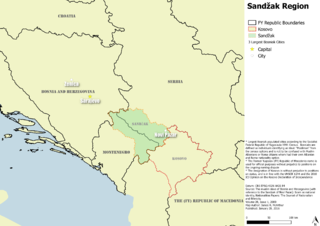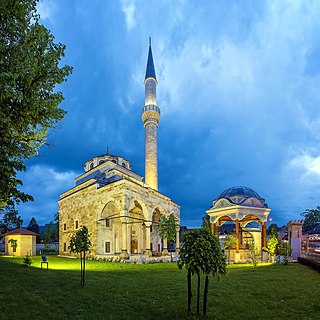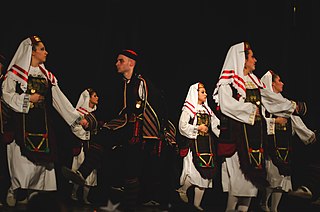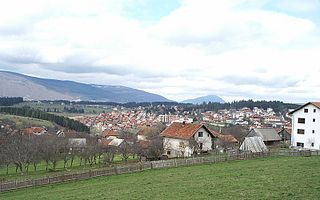
This article is about the demographic features of the population of Bosnia and Herzegovina, including population density, ethnicity, education level, health of the populace, economic status, religious affiliations and other aspects of the population.

Republika Srpska (Serbo-Croatian Cyrillic: Република Српска, lit. 'Serb Republic', also known as Republic of Srpska, pronounced [repǔblika sr̩̂pskaː] is one of the two entities of Bosnia and Herzegovina, the other being the Federation of Bosnia and Herzegovina. It is located in the north and east of the country. Its largest city and administrative centre is Banja Luka, lying on the Vrbas river.

Banja Luka or Banjaluka is the second largest city in Bosnia and Herzegovina and the largest city of Republika Srpska. Banja Luka is also the de facto capital of this entity. It is the traditional centre of the densely-forested Bosanska Krajina region of northwestern Bosnia. According to the 2013 census, the city proper has a population of 138,963, while its administrative area comprises a total of 185,042 inhabitants.

Sandžak, also known as Sanjak, is a historical geo-political region in Serbia and Montenegro. The name Sandžak derives from the Sanjak of Novi Pazar, a former Ottoman administrative district founded in 1865. Serbs usually refer to the region by its medieval name of Raška.
The demographic history of Montenegro can be shown through census results and official documents which mention demographic composition.
The population of the city of Sarajevo's four municipalities is 275.524, whereas the Sarajevo Canton population is estimated at 413.593.

Ferhat Pasha Mosque, also known as the Ferhadija Mosque, is a mosque in the city of Banja Luka and one of the greatest achievements of Bosnia and Herzegovina's 16th century Ottoman Islamic architecture. The mosque was demolished in 1993 at the order of the authorities of Republika Srpska as a part of ethnic cleansing campaign, and was rebuilt and opened on 7 May 2016.

This article is about the demographic features of the population of Serbia; including vital statistics, ethnicity, religious affiliations, education level, health of the populace, and other aspects of the population.

The Serbs of Bosnia and Herzegovina are one of the three constitutive nations of the country, predominantly residing in the political-territorial entity of Republika Srpska.

This article presents information about the historical population of Banja Luka.
This article presents the demographic history of Serbia through census results. See Demographics of Serbia for a more detailed overview of the current demographics from 2011 census.

This article is about the demographic features of the population of Montenegro, including population density, ethnicity, education level, health of the populace, economic status, religious affiliations and other aspects of the population.

This article is about the Demographic history of Bosnia and Herzegovina, and deals with the country's documented demographics over time. For an overview of the various ethnic groups and their historical development, see Ethnic groups in Bosnia and Herzegovina.

Kneževo, formerly Skender Vakuf, is a town and municipality located in northwestern Bosnia and Herzegovina. Administratively, it is a part of the Republika Srpska entity. As of 2013, it has a population of 9,793 inhabitants.

The Croats of Bosnia and Herzegovina, often referred to as Bosnian Croats or Herzegovinian Croats are the third most populous ethnic group in the country after Bosniaks and Serbs, and are one of the constitutive nations of Bosnia and Herzegovina. Croats of Bosnia and Herzegovina have made significant contributions to the culture of Bosnia and Herzegovina. Most Croats declare themselves Catholics and speakers of Croatian language.
Blagovac is a settlement in Vogošća municipality, near Sarajevo, Federation of Bosnia and Herzegovina, Bosnia and Herzegovina.
The most widely spread religion in Bosnia and Herzegovina is Islam and a large portion of the Muslims of Bosnia declared themselves as followers of the Sunni branch of Islam, the majority of Sunnis follow the Hanafi school of thought, also known as a madhab. Bosniaks are generally associated with Islam, Bosnian Croats with the Roman Catholic Church, and Bosnian Serbs with the Serbian Orthodox Church. The State Constitution of Bosnia and Herzegovina (BiH) and the entity Constitutions of the Federation of Bosnia and Herzegovina and the Republika Srpska provide for freedom of religion, and the Government generally respects this right in ethnically integrated areas or in areas where government officials are of the majority religion; the state-level Law on Religious Freedom also provides comprehensive rights to religious communities. However, local authorities sometimes restricted the right to worship of adherents of religious groups in areas where such persons are in the minority. 45% of Herzegovinian and Bosnian Muslims described themselves as Sunni Muslims while 47% described themselves as just Muslims.

Kuljani is a village in the municipality of Banja Luka, Republika Srpska, Bosnia and Herzegovina. It lies about 10 km north from the city on the left side of the river Vrbas.

The Women's Antifascist Front of Bosnia and Herzegovina, usually abbreviated to AFŽ BiH, was a mass organization in the People's Republic of Bosnia and Herzegovina. It was established by the Communist Party in February 1942, over a year before the republic itself, with the aim of mobilizing women in Bosnia and Herzegovina into the Partisan resistance against the Nazi occupation of Yugoslavia. It was one of the organizations which gave rise to the Women's Antifascist Front of Yugoslavia, the first congress of which was held in December 1942 in Bosanski Petrovac.

Hieromartyr Platon, Bishop of Banja Luka was a Serbian Orthodox cleric who served as the Bishop of Banja Luka between 1940 and 1941. His tenure ended in May 1941, when he was abducted, tortured and killed by followers of the Ustaše movement.















